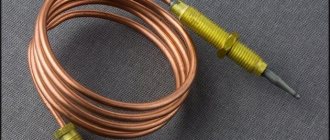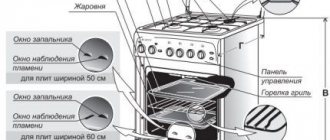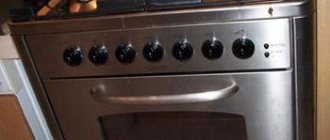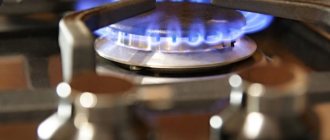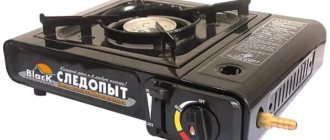How to properly connect a gas stove to a cylinder?
The lack of gas supply in private homes has become not just a problem, but a real headache for the residents of Russia. Most settlements still do not have installed gas pipes, and installing a pipe on the site where a private house is located costs from 155,000 to 320,000 rubles. Yes, such an amount is not affordable for everyone. It is still possible to solve the problem if you use cylinders. Despite the fact that it requires refilling and replacement requires care and attention, anyone can connect a gas stove to a cylinder.
Installation and connection of new equipment
The gas stove replacement scheme is as follows:
- dismantling obsolete or unusable equipment;
- faucet replacement;
- installation of a new slab;
- its connection;
- leak testing;
- acceptance of work by the Mosgaz service in Moscow, Lenoblagaz in St. Petersburg, and so on.
Dismantling a gas stove
To dismantle outdated equipment, you must:
- close the tap located on the pipe to turn off the gas supply;
- check the absence of gas by turning on one of the burners;
- disconnect the gas supply;
- Disconnect the stove from electricity (if necessary).
After completing these operations, the stove can be removed from the kitchen.
Disconnecting old equipment from gas and electricity supplies
Replacing the faucet
If the gas valve does not meet safety requirements or does not completely shut off the gas supply, then before installing new equipment, it is recommended to replace the valve.
As a rule, the equipment is installed and connected by the gas service, since in order to increase the level of safety, it is recommended to disconnect the entire entrance from the gas supply. However, if it is possible to cover it in an individual living space, then having certain skills and all the necessary equipment, you can do the work yourself.
The valve is replaced according to the following scheme:
- crane dismantling. In most cases, threaded valves are installed on gas systems in apartment buildings, the dismantling of which is quite easy. However, in old houses, welded valves can also be installed, the dismantling of which is carried out using a grinder (exclusively after turning off the media supply);
If the work is carried out without turning off the gas and by one person, then after dismantling the tap, a special plug is installed on the pipe. If there are two or more workers, you can plug the pipe with your hands.
- if the thread on the gas pipe is damaged or missing because welded equipment was installed, then at the next stage the thread is cut using special equipment;
- thread sealing;
- removing the plug and installing a new faucet.
Sequence of actions when replacing a gas valve
Installation and connection of a new gas stove
A new slab is installed in the prepared area. When installing, you must level it horizontally. To achieve this, most modern Hephaestus stoves are equipped with adjustable legs. In the absence of such a function, alignment is carried out using various spacers.
Alignment by level
Next, the flexible line is connected to the plate and pipe. For this:
- the thread on the liner (pipe) is sealed with the selected material;
- the eyeliner is fixed;
- Connection to a gas stove is made in a similar way;
Gas hose connection
- if necessary, the stove is connected to the power supply system.
How to install and connect a gas stove yourself, watch the video.
Leak test
After completing all work, you need to check the connections for leaks. The operation is performed in the following order:
- preparing a soap solution;
- applying the solution to the connecting nodes.
If the solution begins to form bubbles, the connection is not sealed and the problem must be corrected before putting the system into operation. The absence of bubbles indicates that the system is completely sealed.
Presence of a leak in the gas supply system
Acceptance of work by the gas service
After all the work has been completed, an application is sent to the gas service to put the stove into operation. At the appointed time, specialists will check the correct connection and tightness. Based on the inspection, permission will be given to use the gas stove or an order to eliminate the identified deficiencies.
If you carry out all the work according to the attached instructions and in a well-ventilated area, you can completely avoid negative consequences when performing the work and save on paying for specialist services.
Existing connection types
Household gas stoves can be connected to both main and bottled fuel. Depending on the gas source on the equipment, the nozzles are simply changed and adjusted . Thus, the possibility of connecting to a gas cylinder is provided in any stove.
Advice! For a summer residence, it is better to purchase budget appliances with one or a pair of burners and a small oven or without it at all. Tabletop stoves that are considered portable due to their small size and light weight, for example, a tourist gas stove, are ideal.
There can be several types of connecting a gas cylinder to a hob or stove.
- Standard connection – one plate is connected to one cylinder.
- Several cylinders are connected to one consumer at once, which is more convenient. In this case, when the mixture in one container runs out, the user can quickly switch to another and not be left without fuel.
- Another way is to connect two gas stoves to one cylinder (more is possible). There are no significant differences from a regular connection. Additionally, you will need to purchase a divider into several hoses, each of which is connected to a separate fuel consumer.
Expert advice
To summarize, we can highlight a number of rules that experienced craftsmen adhere to:
- access to hose connections and valves must be free;
- the hose should be positioned freely behind the stove, without bending or pressing against the wall;
- the hose cannot be painted, as paint can damage the material of the product and cause it to crack;
- all work is carried out with the gas turned off;
- if necessary, plug the pipe, use a damp cloth made of thick fabric;
- upon completion of the work, be sure to wash the docking units to detect possible gas leaks. The appearance of bubbles indicates insufficient tightness of the unit.
Built-in equipment is very popular in the kitchen.
Features of the technology
A standard household gas stove consists of two parts: a hob and an oven. In the classic version, both the oven and the hob have one solution: they run on gas or electricity. In combined models, gas is burned in the burners, and the oven runs on electricity.
Stove with gas hob and electric oven
Hobs can be made of enameled or stainless steel, glass ceramics or anodized aluminum. Most modern models are equipped with burners of different diameters. The larger the burner, the higher its power. The combination of burners of different power allows you to cook food in dishes of various capacities as conveniently as possible.
Cooking surfaces can be equipped with very good functionality and safety systems: electric ignition, simmering function, continuous burning, gas shutoff when the flame goes out, etc.
Electric ovens in combined gas stoves can be of two types:
- Classic. Structurally, classic ovens include an upper and lower heating element. Optionally, they can be equipped with a spit and (or) grill grate;
- Multifunctional. In addition to the classic arrangement of heating elements, multifunctional equipment can have additional side and rear heating elements, be equipped with convection, self-cleaning and even microwave functions.
Classic oven device
It should be understood that the presence of a lot of options in the oven not only simplifies the operation and maintenance of the device, but also significantly increases its cost
That is why, in order not to overpay when choosing a gas stove with a multifunctional electric oven, you should pay attention to models with only the options you need
Electric oven with convection
The best gas stoves premium segment
Top-end cookers are the ones to buy if you want the superior functionality and impressive reliability you're willing to pay for. Of course, the cost of over 30 thousand rubles is not affordable for everyone. But keep in mind that kitchen appliances, as a rule, are not purchased for one or two years, but serve for decades. And so that during all this time you do not have problems with it, you should initially spend more. And in appearance, premium gas stoves also outperform other categories.
GEFEST 6700-04
And one more, already the third Gefest gas stove in our rating. Model 6700-04 features a stunning modern design. The clearly defined legs look unusual, but this solution will harmonize perfectly with the corresponding set. In the oven with a volume of 52 liters, the manufacturer has provided high-quality lighting, gas control and, of course, a grill with a spit. There is gas control for each of the 4 burners. Among them are two standard ones, and one more each – fast and “triple crown”.
But the advantages of the stove do not end there. The timer and display add convenience to the GEFEST 6700-04. But it's a pity that there is no clock function here. But automatic electric ignition is available for both the oven and the burners. The sides of the device are made of stainless steel. The working area is made of tempered glass
This option looks simply amazing, but requires careful handling and care. But cast iron grates will ensure reliability and durability in almost any conditions
Advantages:
- great design;
- body materials;
- double oven lighting;
- triple crown burner;
- full throttle control;
- automatic ignition;
- customizable timer.
Flaws:
oven size.
Electrolux EKG 96118 CX
Good functionality of technology is wonderful. However, this is not enough if the buyer is not satisfied with its appearance. Therefore, we recommend that connoisseurs of attractive design choose a good gas stove with a width of 60 cm from the Swedish brand Electrolux. The EKG 96118 CX is a great buy in every way. There is a timer, 4 burners, one of which is a triple crown, and a spacious 61-liter oven with an electric grill. The working surface of the stove is made of stainless steel, but if for some reason this option does not suit you, then choose the modification with the CW index (white enamel coating).
Advantages:
- high-quality assembly;
- attractive design;
- great functionality;
- convenient switches;
- customizable timer;
- Triple crown burner.
Gorenje GI 6322 XA
As we noted earlier, the GI 6322 model can claim a place in two categories. That's why we added it to both at once. But the modification with a stainless steel case costs more than 30 thousand rubles, so it is not the same interesting choice in terms of balance between price and quality. However, in other respects it is still the same model, and in reviews the Gorenje GI 6322 stove in silver is given equally high marks.
Advantages:
- customizable timer;
- stylish design;
- electric ignition;
- The kit includes a spit;
- triple glass oven.
Flaws:
features of stainless steel.
Kaiser HGG 61532 R
Kaiser gas stoves of the XL 500 Plus series are an excellent choice for the modern kitchen. The company produces units in two versions - 60 cm and 50 cm wide. The size is indicated by the first digit in the model name (6 or 5, respectively). Regardless of its size, the popular stove from Kaiser is equipped with 4 burners of different power. To adjust the latter, rotary switches are used.
Many HGG 61532 owners have appreciated the automatic ignition, thanks to which you do not need matches or a lighter. There is also a sound timer and gas control for the burners and oven. The latter has a volume of 60 liters, as well as an infrared grill function. Included with the full-size gas stove model HGG 61532, the buyer receives a baking sheet and a spit.
Advantages:
- working surface made of tempered glass;
- separate cast iron grates;
- quality of materials and components;
- quick heating burner;
- infrared grill;
- gas control.
Flaws:
high price.
Connecting the cylinder to a gas stove
If a person does not know the rules for connecting a gas cylinder, it is better to contact a qualified specialist. But there are times when it is impossible to call a specialist; most likely, such cases occur in summer cottages. If you follow the installation rules, then anyone can connect the cylinder.
Preparation of materials
Preparation for connecting the cylinder must have the following required elements:
- A special stove for a country house, designed for installing a cylinder.
- An appropriate container, that is, a propane gas cylinder.
- Special mechanism for normalized gas use, reducer.
- The gas hose must be at least a meter long, this is in accordance with the correct distance between the stove and the gas container. In this case, the hose should not be taut. The best length option is 2 meters.
- For a rubber hose, you must have fittings and screw clamps that connect to each other. If the hose is bellows, you need adapters with threads.
- To check the connections between the hose and the cylinder, you must have a soap-based solution. After installation, it is used as a testing tool; if there is a leak, soap bubbles appear. Then you need to carefully reconsider the connection.
Reference! For high-quality installation of the cylinder to the stove, it is better to buy elastically flexible hoses to avoid deformation and cracks leading to leakage.
How to choose the right jet
Gearboxes with the possibility of reverse regulation are recommended for use in propane tanks. One requirement is that the reducer must match the size of the cylinder used.
When choosing a reducer, you need to take into account the temperature of the room in which the gas cylinder will be used. It often happens that the supply of gas through the reducer is difficult, since low temperature makes the gas liquid. In such cases, you need to buy a gearbox with a special heating system.
Features of equipment selection
Installation of a cylinder in an apartment, house or country house must follow all safety rules.
When installing gas equipment, there are several options. Let's consider three types of connection.
- Use of bendable hoses designed for combustion media. The gearbox is installed using a standard fitting and a screw clamp; a fitting is also installed at the inlet of the gas stove. To connect the gas pipeline, use a conical thread. When choosing a hose, you need to adhere to the length, it should not be more than one and a half meters, for a good overview of the condition of the shell and to identify various types of damage. You can also use bellows hoses; they are resistant to temperature changes and various damages. Installing flexible hoses through walls is strictly prohibited. If such a need exists, you must adhere to all the instructions, which means that the concrete hole in the wall must be with a special metal foil. In the middle, there should be a smaller metal pipe. The remaining space can be filled with silicone-based sealant.
- The connection has a gas tap installed, it is used to stop the supply of the flammable mixture. Locking is also necessary for the safety of the oven. There are two types, ball or plug valve, used for periodic maintenance.
- Additional materials, this is a metering device, it is connected to the gas supply unit. Accounting is necessary, since when gas is consumed, the device reacts and delivers the combustible mixture. Such a device is installed on backbone networks.
- When connecting several cylinders, a connecting ramp is used. The device reduces gas evaporation and minimizes the risk of cooling in the nozzle. You can install the device yourself, if you have the gas pipeline material.
Determining a place for a gas cylinder
For the correct installation of the gas cylinder and stove, there are some recommendations that will ensure people's accommodation. After all, the most important thing is safety. It is prohibited to install containers in rooms intended for the habitation of house residents. Propane gas is heavier than air, and at the slightest leak, the gas will accumulate on the lower floors.
Gas cylinder in the country - advantages and disadvantages
When a person just moves into a private house that is not connected to a gas pipeline, he finds himself at a crossroads - use an electric stove, or connect a gas stove, but use cylinders? Both solutions have a number of advantages and disadvantages.
The positive aspects of a gas cylinder are:
A gas burner will heat everything several times faster. Cooking time will be significantly reduced, which means you will have more time for yourself or your family.- The cost of refilling is much less than paying bills for used electricity. The only exception may be when you use electricity at preferential rates, for example, for people living in villages. There is also a discount on utility bills for those considered low-income.
- In certain regions, the rate of electricity consumption per person registered in the premises is limited to 50 kW per month, and if the limit is exceeded, the price increases.
Now about the disadvantages:
- Transportation costs, since there are gas stations, but they are much smaller than gasoline ones.
- It is impossible to know exactly how much fuel was filled into the cylinder.
- Installation of gas stoves in rooms where there is no ventilation is prohibited.
When we have figured out all the pros and cons, and you have decided to install cylinders, you can talk about where to place the fuel and stove.
How to connect using a pipe?
This option is rarely used due to the complexity of installation. Installation using this technology is carried out using a pipe of a certain length, bent at a given angle, with a thread. The latter will be required for screwing on the couplings through which the household appliance is connected to the gas pipeline.
In practice, two connection options are used. The first involves the use of two couplings, with the help of which the pipe is connected at one end to the gas pipeline, and at the other to a household appliance. The second option is more complex in terms of execution technology. In this case, one end of the pipe is welded to the gas pipeline, and the second is connected to the outlet pipe of the stove using couplings.
A third option is also used. In this case, copper pipes are used, to the ends of which fittings with union nuts are soldered. But, regardless of the chosen connection method, this type of connection does not allow the gas stove to be moved to the side if necessary.
How to avoid accidents
The use of gas equipment is a hazardous activity. To prevent trouble, you must follow several rules:
- Do not leave the burners on for long periods of time unattended, especially at night.
- Do not place cookware on burners without grates.
- You cannot bring fully filled cylinders from a cold place into a warm room. Expanded gas can rupture the container.
- Do not illuminate the meter with a lit match when checking.
- Do not tie ropes to clothes drying pipes.
- Do not allow young children to turn the stove on and off.
Difference in slabs
Kitchen stoves sold in stores use natural gas - methane - for combustion. The nozzle, which is located inside the burner, is designed to operate on this type of fuel. If such a stove is correctly connected to a gas cylinder, as many try to do, it will not work effectively. The flame will not create the required temperature and will smoke. This happens because the propane-butane mixture is in a liquefied state, while methane is in a gaseous state under pressure. More liquefied gas flows per unit of time, so the jets must be smaller. Therefore, before connecting the gas cylinder to the stove, the nozzles should be replaced. They come complete with the stove.
To change them, you need to remove the top surface of the kitchen appliance. To do this, remove the burners. Then release the side clamps and remove the top cover of the stove.
Changing the nozzle in the oven is also not difficult. To do this, you need to remove the back wall of the oven, after which access to the inside of the oven will open. The nozzle is connected to a gas supply tube, which is fixed with a metal bracket on the body. There is a rubber gasket between the tube and the nozzle, which must be installed when replacing the nozzle. It is very small and may not be noticed. It must be removed carefully so as not to damage it.
Do-it-yourself connection to the stove
To make your own connection, you need to choose the right fittings:
- Hoses. They must be designed for a propane mixture and able to withstand operating pressure. They should be checked for cracks, and if the cylinder is installed outdoors, it would be advisable to run a pipe into the room from the place where the gas cylinder is located.
- Household type gas reducer for propane. It differs from the industrial one in that it has a narrow range of pressure regulation, and also it does not have a pressure gauge, and it has a low price. The throughput is 1.2 m3/hour. On one side it has a nut for connecting to the cylinder, and on the other there is a fitting for the hose.
- Clamps for fixing hoses to the fitting.
In addition, in order to connect the gas stove to the cylinder, you will need a screwdriver to tighten the clamps and a gas wrench. When changing cylinders, be sure to monitor the condition of the gasket, which is located under the gearbox nut. If it is faulty and not replaced, it will result in excessive fuel consumption. You can install the upper part of the plastic cover as a gasket, and to do this you only need to make a hole in the center and cut it to the required size.
To avoid accidents
The use of gas-powered equipment can be classified as a hazardous activity, and in order to prevent unpleasant incidents, follow the following rules:
- Do not leave the burners on unattended for long periods of time, especially at night.
- It is prohibited to place cookware on burners that do not have a grate.
- You cannot bring completely filled cylinders from a cold place into a warm room, as the gas may rupture the cylinder when it expands.
- Do not illuminate the meter to check readings with a lit match.
- Do not tie ropes to pipes to dry laundry.
- Do not allow children to turn the stove on and off without your help.
Such simple rules will help you save your life.
Why do you need a gas stove for a summer cottage under a cylinder?
Modern man is accustomed to convenience. He is not satisfied with decisions that are accompanied by unnecessary difficulties. From this point of view, the most convenient option is electricity. A stove equipped with an appropriate heater is easy to use. The position of the regulator precisely sets the temperature regime. The requirements of safety rules are easily met.
Such exotic “equipment” is used as an entertainment attraction. The practical value of a classic samovar is minimal
The advantages of electric heating are obvious. But it is necessary to note the disadvantages that complicate its use:
- high cost of energy resources;
- dependence on the functionality of centralized networks;
- high power consumption;
- stationary placement.
The use of solid fuel causes significant inconvenience. Wood-burning ovens create a unique aroma in dishes. But they take a long time to melt. They take up a lot of space and unnecessarily raise the indoor temperature after cooking is complete. Such equipment must be connected to the chimney. To implement the project, significant financial investments and labor costs will be required.
Stoves in dachas perform decorative functions. They are used as an effective means of heating when weather conditions worsen.
If you evaluate the significant factors as a whole, it is not difficult to draw a preliminary correct conclusion. A gas stove for a summer house under a cylinder is a profitable option:
- It weighs little and takes up little space.
- A personal fuel supply provides good autonomy.
- The equipment is ready for immediate use after connection.
- Its movement is not accompanied by unnecessary difficulties.
The best gas stoves with electric oven
Another popular type of such equipment is a gas stove with an electric oven included. This is a combined type that has its own pros and cons. The double-sided arrangement of special heating elements in the oven ensures uniform cooking without burning, and a gas stove will save money on electricity bills.
Hansa FCMW68020
The Hans gas stove with electric oven is an appliance with the signature Integra design of an energy-efficient gas-electric look. High quality construction, strength of metal elements, and stainless steel coating ensure a long service life of the equipment. The cast iron grate can easily support large-volume dishes without even a hint of sagging. The mechanical type of control and automatic ignition make it easy to handle 4 burners, as well as an oven with a capacity of 62 liters. There is a function of confectioning, quick heating, defrosting, upper/lower heat and grill.
Advantages
- Spaciousness and rich functionality of the oven;
- Thick, rigid grille;
- Easy electric ignition;
- Large box for storing accessories;
- Gas stove with electric oven with convection.
Flaws
- There is no gas control;
- Difficulty in cleaning handles.
Reviews from housewives focus more on the oven, as it copes with all tasks perfectly, producing ideal dishes. Non-stick baking sheets guarantee a long service life, just like the stove itself. Only the backlight can fail over time, as evidenced by some user comments.
The best TVs for your home
Electrolux EKK 951301 X
This model from a well-known brand will become a bright accent in the kitchen thanks to its silver body and attractive design. The combination of 4 burners and an oven with a capacity of 56 liters will make the cooking process quick and simple. There is automatic ignition and rotary buttons for control. The reliability of the device is guaranteed by the durable stainless steel housing. The oven is equipped with lighting, confectionery, and grill.
Advantages
- Combination of electricity and gas;
- Good lighting;
- Simple controls;
- Stainless steel hob;
- Fast oven heating;
- Durable cast iron grates.
Flaws
- Electric ignition is installed only on the stove;
- Difficulty cleaning handles.
With low gas and electricity consumption, the device quickly and efficiently copes with various tasks. Reviews confirm that the stove will serve the owner for a maximum period of time if handled with care.
Gorenje K 63 INI
This convection oven, powered by electricity, offers the owner 9 cooking programs for almost any dish, including baked goods. The model differs from previous nominees in the specially designed and implemented GentleClose hinge, due to which the door will open smoothly and silently and return to its original position. The IconLED touch display allows you to select the desired program with one touch, there is a sound signal, and an automatic cooking mode. The uniform distribution of hot air creates the effect of cooking in a Russian oven. High safety is due to gas control of each burner, and the fan in the oven quickly cools the device and ensures confection.
Advantages
- Multifunctional oven;
- Touch control;
- Timer;
- Smooth and silent door opening;
- Unusual design;
- Gas control on each burner;
- Convection.
Flaws
- High price;
- Large model.
A spacious, large oven with an oven will require more free time, but this is not just a household appliance, but a whole miracle factory that makes cooking as easy as possible. Here you can postpone cooking the dish for the desired time thanks to the timer. The large, spacious oven allows for simultaneous cooking on five levels.
Is self-connection allowed?
Almost all gas workers unanimously claim that connecting a propane cylinder to a gas stove should be done exclusively with their participation, having paid them money for calling a technician. However, this connection can be done with your own hands without additional costs.
There is nothing fundamentally complicated about this issue. Connecting a gas hob to a cylinder involves choosing a place for a container with fuel and organizing an outlet from there in the form of a pipe or flexible hose to the stove.
Whether the cylinder is connected to the stove yourself or by calling a gas fitter - according to the law, all responsibility for the safe operation of gas appliances lies solely with the owners or tenants of the residential building
To perform such work, you only need to have basic skills in handling wrenches. Plus, you will have to carefully study and fully comply with fire safety rules for gas-powered equipment.
A household propane cylinder can be installed both inside and outside a residential building. But fire safety standards recommend choosing a place to store gas outside, and not in the kitchen or utility room of the cottage. If installed outdoors, you will need to install a longer pipe or hose, but the likelihood of a fire and/or explosion will be less.
Space for cylinder
Using energy resources is not a cheap pleasure. But if you choose between electricity and blue fuel, then the residents of our country prefer the latter. Natural gas is not just more affordable. Its cost is several times less than electricity.
And since gasification in the country is more or less established, our houses are mainly heated with blue fuel, and our kitchens have gas stoves. And only those buildings that have not yet been connected to a gas pipeline have to be content with electricity. But even in this case, there is always an opportunity to save money.
If there is no gas line, then household equipment can be connected to bottled fuel. Using heating, of course, will be unprofitable. But a kitchen stove powered by gas from a cylinder will be much more profitable than an electric burner.
Connecting a gas cylinder to a stove in the country begins with finding the right place to install the equipment. In this case, it is necessary to follow safety standards in order to avoid dangerous situations for the lives of others. Because liquefied gas has a high density and can quickly accumulate indoors.
A very dangerous neighborhood Source technosova.ru
In this regard, installation of a cylinder is prohibited:
- in living rooms;
- in spaces without ventilation;
- in basements;
- in rooms whose ventilation is connected to living rooms.
Most often, one of two options is chosen for a country house. The cylinder is placed directly next to the stove. The cooking room usually has a window. Therefore, the room can always be ventilated.
It is only necessary to maintain the distance from the gas cylinder to the stove. For safety reasons, it should be at least half a meter. You also need to make sure that the container does not come closer than a meter to the heating devices.
It would be more correct to install a gas cylinder at the dacha on the street. An iron cabinet is installed immediately behind the outer wall of the kitchen, which is installed on a wooden pallet. The internal dimensions of the box in height should exceed the standing cylinder by 20-30 cm.
The place must be equipped with a canopy. To avoid direct exposure to sunlight and avoid heating the container above +40 °C. Also, such a measure will help protect the system from water ingress. And for those who are going to use bottled gas in winter, you will need to either properly insulate the cabinet or use a special frost-resistant mixture.
Fuel container in a special outdoor cabinet Source lenbyt.ru
See also: Catalog of companies that specialize in autonomous gasification of country houses and related work
How to proceed?
You take any of the steps described below at your own risk. The site administration is not responsible for any negative consequences associated with such an installation. To work you will need:
- jigsaw (can be replaced with a circular saw);
- FUM tape;
- mounting adjustable wrenches;
- toilet soap solution.
To properly connect the hob, you first need to select the installation location. Most often they try to bring the equipment closer to the gas mains. But if redevelopment is necessary (or possible), bellows corrugated hoses are used. Next, using a cutting tool, prepare a hole of the required size in the tabletop. Remove all dust and remaining sawdust.
The next step is to stick a special foam tape around the perimeter of the recess. It is either taken from the delivery kit or purchased separately in specialized gas equipment stores.
Next, you need to connect one of the ends of the flexible hose to the main pipe or to the cylinder. The opposite end is connected to the inlet channel of the hob. The required hole is located at the bottom of the household appliance.
Therefore, when connecting gas hoses to a built-in model, you need to open the doors and remove the shelves on the corresponding cabinet. The hose is screwed tightly, it must be sealed with FUM tape. Next, turn the valve to the “fully open” position. The burners are not lit.
It is necessary to cover all joints with soapy water. Normally, no bubbles should appear. But let’s assume that foam still appears. Then you need to tighten the nut again in the problem area. Then they check it again with foam. The procedure is repeated until even small gas bubbles stop appearing.
Most standard kits include two types of jets. The one with the thicker hole is for main gas. The one with a smaller inlet is for connecting to cylinders. By default, the nozzle for connecting to the gas pipeline is always installed. If there is a need to change it, use the keys included in the kit.
Gas panels with electric ignition will need to be connected to the electrical network. You need to place an outlet near the household appliance. Its permissible load is determined very carefully. Ideally, not only the maximum current consumption should flow freely through this outlet, but a reserve of about 20% in power should be provided. Hobs are always mounted on thick countertops (wood layer at least 3.8 cm).
If you try to install the panel on a thin base, the system may suddenly fail. According to standard rules, hobs with electric ignition are installed using any hoses except those with a metal braid. No matter how good such hoses are, they can lead to fire and gas explosion if a short circuit occurs.
To learn how to properly connect gas to the hob, watch the following video.
Safety requirements when working with gas equipment
When operating gas equipment, knowledge of the norms and rules of connection is required, which makes operation safe for the user. If the gas stove is correctly connected to the cylinder, accidents during its operation are rare and are associated with careless operation and ignoring safety rules.
List of basic requirements:
- The need to undergo training at the gas management organization on the safe use of devices.
- Monitoring by the consumer of the correct operation of appliances, chimneys and ventilation.
- Check the chimney draft before using gas appliances. Before using a gasified oven, check the “open” position of the gate to the maximum. Clean chimney bends regularly.
- After finishing using bottled gas, you need to close the tap on the gas appliance and in front of it, and when placing the cylinder indoors, additionally close the valve on the cylinder.
- If the equipment malfunctions, inform the specialists of the company serving the consumer.
- If the gas supply suddenly stops, you should quickly turn off the burner valves of the gas appliance and call the emergency service by phone 04.
- If you smell gas in the apartment, you should immediately stop using the appliances, turn off the valves on them and the supply pipelines, open the doors and windows to ventilate the room, and call the emergency service by calling 04 (from another room). It is prohibited to light a fire, smoke, or use electric lighting or electrical appliances.
Features of operation of gas cylinders
The liquefied gas in the cylinder is under pressure, and when it is supplied to gas equipment, it transforms into a gaseous state.
This process is accompanied by a sharp decrease in temperature, and with intensive use of the equipment, the temperature can drop to a critical value at which further conversion becomes impossible.
The simplest solution is to reduce gas consumption. You can also resort to additional heating of the cylinder, but it is prohibited to use heating sources with an open flame. Insulation of gas cylinders is not allowed, but it is possible to use special “heating jackets” and thermal covers.
Thermal covers protect gas cylinders from critical temperature drops
Owners of gas cylinders may encounter similar difficulties in winter if the cylinders are located in an unheated room. In this case, it is best to use special propane-butane mixtures with different percentages of components.
The standard gas mixture for the warm season contains 60% butane, 40% propane. A winter mixture for critically low temperatures may contain 80% propane and 20% butane, but such a mixture is much more expensive.
Cranes and accessories
Although each cylinder is equipped with a shut-off valve, experts advise installing a duplicate element on the system. A ball or plug valve will do, but be sure to have a yellow handwheel. All gas products are marked in these colors.
If desired, you can install a flow meter. This useful detail will allow you to prepare in time to change the cylinder when it runs out of fuel. There is no need to choose a very accurate and expensive device. A budget design can easily cope with simple functions.
To reduce the degree of evaporation of the working mixture from the cylinder, many install a connecting ramp. But in this case, it is necessary to use at least two containers simultaneously. This will reduce gas consumption. This detail will also reduce the likelihood of the mixture freezing in the gearbox.
Connecting ramp for gas cylinders Source mrklimat.ru
Installation of gas supply
Installation of the bellows gas hose is carried out in compliance with the following rules:
- it is unacceptable to hide the liner in the wall, since any leak that is not detected as soon as possible can lead to emergencies, damage to property and loss of life;
- Do not install a hose with a large number of kinks;
- condensation on the equipment will help reduce the service life of the liner.
Installation diagram:
- choosing an installation location in accordance with the recommendations given above;
Optimal connection diagram for a gas stove
- turning off the gas supply to the premises. To make a temporary shutdown, you can use the tap installed in the apartment, and if it is missing, you need to contact the management company;
Individual gas shut-off valve
- dismantle the old eyeliner (if any);
- if the supply line and tap are missing, then before connecting the equipment, it is necessary to cut a thread on the pipe and install a tap that allows you to shut off the gas supply directly in the living room. For example, to troubleshoot equipment;
- dielectric installation;
- A flexible hose is connected to the tap. As a rule, in this situation, the “nut” connection method is used;
When connecting the liner, special attention is paid to installing the sealing gasket. A connection without a gasket will not be completely sealed. To increase the tightness, you can additionally use FUM tape or other similar material
To increase the tightness, you can additionally use FUM tape or other similar material.
- connecting the supply to gas equipment using an o-ring. All nuts and fittings must be fixed using an open-end wrench without unnecessary effort. Even slight overtightening can lead to damage to the seal and rapid depressurization;
Connecting the liner to the equipment
- examination. To identify a leak, you can use a soap solution and an ordinary brush (sponge). If soap bubbles appear on the surface when applying the solution, then the connection is not airtight.
Leak detection with soap emulsion
How to connect a gas stove yourself, watch the video.
If you cannot install the equipment yourself, it is recommended to contact gas service specialists. Replacing the eyeliner will cost approximately 300 - 500 rubles.
How to refill a cylinder
When the stove is not in use, the cylinder valve must be kept closed. If you need to turn off the tank for refilling, the valve must also be closed. When refueling at the station, be aware that the tank is filled with less than the indicated capacity. There is always free space in the cylinder. Therefore, when filling a 50-liter cylinder, you pay about 40 liters.
Users should also be aware that non-volatile impurities - condensation - accumulate in the container. So that it does not take up space, they get rid of it. Condensate can be flammable, so it is better to pour it out at specialized stations.
Gas stoves using liquefied gas have long been used in dachas. If you have certain knowledge and experience, you can connect bottled gas yourself. But it is better to contact specialists who can professionally perform this work, ensuring the safety of further use.
Connecting the hose to the gas stove
To connect the hose to the stove, look at the back of the stove. Here you can see the inscription “exit”. You will immediately need to determine what type it is. Perhaps it will be made absolutely straight or have a slight angle.
This is very important, so the hose is not allowed to bend too much. If the pipe is located a little to the side, and the outlet is made straight, you will have to purchase an additional metal elbow with a thread. When the thread diameter is 3/4 inch, you will also need to install an adapter (foot) with a diameter of half an inch
When the thread diameter is 3/4 inch, you will also need to install an adapter (foot) with a diameter of half an inch.
Usually in all kitchens the gas riser is installed in a certain corner. A welded tube equipped with a ball valve extends from it to connect a gas hose.
The union nut is screwed onto the tap. When the faucet has an internal thread, the hose must screw into it.
Before connecting a hose to the “output” of the system, you need to install a paronite gasket. It is usually sold as a set.
But it is better to purchase such a gasket on the market, equipped with a metal mesh. It will serve as protection against possible contamination.
Having installed the gasket, the flexible hose is screwed to the outlet of the stove and tightened with an open-end wrench.
Then a gas leak check is carried out. All connections must be thoroughly washed. Open the tap and let in the gas. The absence of bubbles at the connections indicates that the system is ready for use.
Is self-connection allowed?
Almost all gas workers unanimously claim that connecting a propane cylinder to a gas stove should be done exclusively with their participation, having paid them money for calling a technician. However, this connection can be done with your own hands without additional costs.
There is nothing fundamentally complicated about this issue. Connecting a gas hob to a cylinder involves choosing a place for a container with fuel and organizing an outlet from there in the form of a pipe or flexible hose to the stove.
To perform such work, you only need to have basic skills in handling wrenches. Plus, you will have to carefully study and fully comply with fire safety rules for gas-powered equipment.
A household propane cylinder can be installed both inside and outside a residential building. But fire safety standards recommend choosing a place to store gas outside, and not in the kitchen or utility room of the cottage. If installed outdoors, you will need to install a longer pipe or hose, but the likelihood of a fire and/or explosion will be less.
Read also: How to wean a chicken from hatching eggs
Features of equipment selection
Several recommendations for choosing gas equipment:
- Plate. If you are using an old unit, before connecting it is necessary to check that the fastenings and burners are not damaged and are working.
- Gas reducer. The main part when connecting bottled gas. It regulates the propane pressure at the outlet and lowers it to the required level. Must be equipped with threaded connections with brass nuts. For a cylinder with a valve, model RDSG 1-1.2 is used, for a container with a valve RDSG 2-1.2 is suitable.
- Hose for connecting the plate and cylinder. Purchased at specialized sales points, it must be intended specifically for gas. Its length must exceed the distance between the connected equipment by 150 cm, since it is prohibited to use it in a tense state.
Important! Do not use old hoses, as the integrity of their internal surface may be damaged.
What hoses and tubes to use for connections
According to the rules for the safe operation of gas equipment, oxygen and hydraulic hoses are not allowed to be used for laying gas pipelines. This is due to the high temperature difference between the transported gas and the external environment, which leads to accelerated degradation of the hose material and the appearance of microscopic leaks. Given the properties of liquefied gas to accumulate in rooms, such phenomena pose an increased danger.
There are three options for connecting a gas cylinder to a stove. The first is to use special flexible rubber hoses for flammable hydrocarbons. In this case, their connection to the gearbox is made through a standard fitting reinforced with a screw clamp. The same fitting is installed on the inlet pipe of the gas stove, the hose is connected to it also with a clamp. If it is necessary to connect two sections of hose, the use of double-sided fittings is not allowed; instead, threaded connectors with double crimping of the shank with clamps should be used. A distinctive feature of such connections for gas pipelines is the tapered thread and the absence of elastic seals.
Connecting the plate to the cylinder using flexible hoses has a number of limitations. The length of the hose should not exceed 150 cm, its gasket must remain visible to constantly monitor the condition of the sheath and avoid damage. Some of the prohibitions can be partially circumvented by using metal bellows hoses. They form a semi-rigid structure, which can have an almost unlimited extent, while maintaining resistance to temperature influences and mechanical damage.
At the same time, safety rules prohibit the passage of flexible and semi-flexible ducts through walls, where their condition cannot be assessed visually. If it is necessary to connect a kitchen stove to a cylinder installed outside, a steel pipe case should be embedded in a hole in the wall using cement mortar. Inside the case there is a steel tube of smaller diameter with threads at both ends; the space between the walls is filled with a plastic sealant, for example, polyurethane foam or silicone. Connection of bellows or flexible hoses must only be made through threaded adapters of the appropriate type.
Using bottled gas
At the dacha, liquefied gas can be connected to a stove, smokehouse, and, if necessary, to a gas heater. A comfortable stay at the dacha will be ensured - the process of cooking and heating water will speed up. All this is guaranteed only with professional connection, knowledge and compliance with the rules for the safe use and storage of gas cylinders.
Why in a cylinder?
If natural gas is not supplied to the dacha, liquefied propane - butane mixture is used instead. Its liquid state of aggregation is explained by the high pressure under which it is located in the cylinders. It is convenient to use, transport and store such gas.
